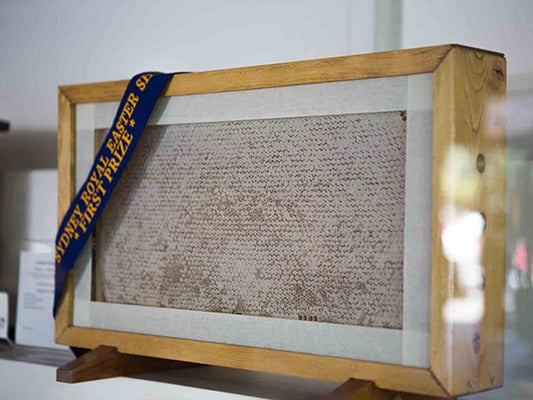
The creation of comb honey is an art form in the field of beekeeping. Honey in the comb is seen by the general consumer as something ‘pure’ and ‘natural’. Invariably this is true, as there has been little or nothing done to the product from the hive to the consumer. Even so, care needs to be exercised with the production and processing for the final product to reach the market in its best possible condition.
Not all sources of honey are acceptable for comb honey production.
- Some flowering events are unreliable and nectar secretion may start and stop quickly
- Some sources of honey have objectionable flavours. An example is privet (Ligustrum species) or guioa (Guioa semiglauca) on the NSW North Coast
- Some honeys crystallise very quickly and, as such, do not have the proper visual appeal
- Some honeys have a less than desirable aroma and should be avoided for comb honey production
- Single-floral honeys attract a greater premium
What are you going to produce?
Comb honey or cut comb is where a comb of honey is cut up into blocks and placed into containers
Chunk honey refers to the cut honey being placed into jars and the jar filled with a light, pleasant flavoured honey. This allows the comb to be readily viewed through the jar.
Section honey is where several small purpose-made frames are placed into a regular frame and the comb is not removed or cut out of these boxes. Sections can be made with timber or plastic frames. Section honey production is the most difficult to ensure a high success rate.
Video:
Bruce White, international honey judge, gives tips on producing comb and chunk honey
Production, storage and processing
Thin foundation is often used in comb honey production, as this provides a better texture to the palate when being chewed.
Once the comb is capped, the honey is ripe and should be removed from the hive as soon as practical. The combs need to be fully capped to have their greatest appeal.
Leaving full combs/sections on the hive may lead to travel stain from the movement of bees across the face of the comb. When removing boxes of combs or individual combs it is important to prevent and avoid any robbing by field bees. Robbing bees will chew holes in the cappings of combs and detract from the look of the comb honey.

The winning comb honey at the 2017 Sydney Royal Easter Show
Source: Emmanuel Farrugia saveourbees.com.au
The comb structure should be all new and white in colour. This also means that the physical structure and integrity of the comb is not as robust as older, darker comb. Thus, comb honey can be damaged easily if roughly handled.
Careful handling of boxes and combs is a must, with particular care with the transport of combs from the field back to the factory. Due diligence must be paid to ensuring that the comb is sealed against moisture, particularly rain, and also protected against dust.
Combs should be stored in a fridge or freezer to avoid damage from insect pests. Freezing for 24 hours will kill all stages of most insect life cycles. Long-term storage at refrigerated temperatures is not recommended as this will promote crystallisation. The best way to store comb honey is in the freezer.
Sections need to be removed from their supers or larger boxes and wrapped or housed in individual containers. Combs need to be cut into appropriately-sized pieces and placed in the desired containers, either purpose-made containers or jars. Any honey that is added to these containers to improve the look of the saleable item should be pasteurised to reduce the likelihood of the honey being seeded, leading to the honey candying.
The processing of the honey combs should be conducted in a food grade premises, free of dust and insects. Records of each batch should be maintained with a trace back system in place.
Acknowledgements:
- Adapted from Doug’s Column in Australia’s Honeybee News, Volume 12, Number 3, May – June 2019
- This article was written by Dr Doug Somerville and reviewed by Liz Frost and Nadine Chapman.


2 comments, add yours.
Ilija
Hi,
I have two questions. First: can i make honey comb if i first put in frame wex honeycomb (probably have small dose of paraffin)?
Second: long time saving comb honey, where is the best location and which temparature have to be?
Thank you forward
Kind regards
ruthluckner
AuthorHi,
100% beeswax foundation is recommended to start honeycomb for human consumption. Paraffin contaminated beeswax foundation can lead to collapse of combs and can have a negative influence on honey bee development.
Best storage of honeycomb is in the freezer to maintain the honey in a liquid state.